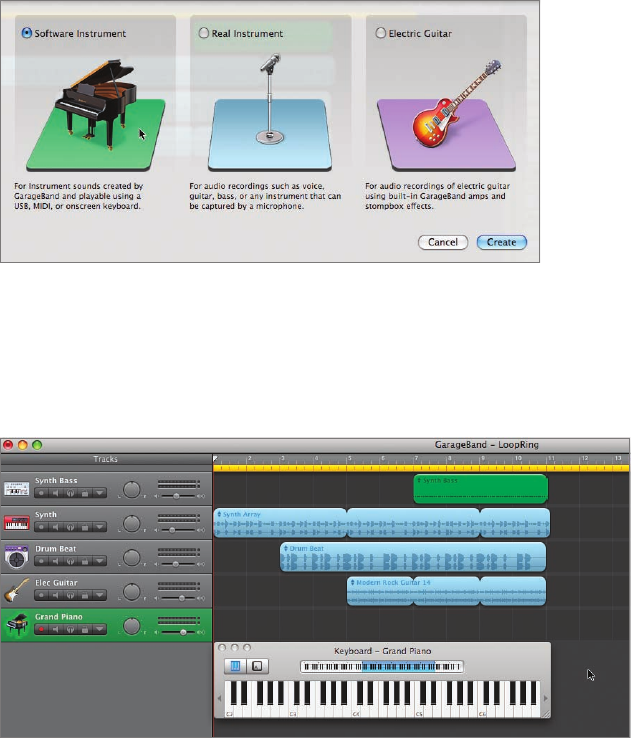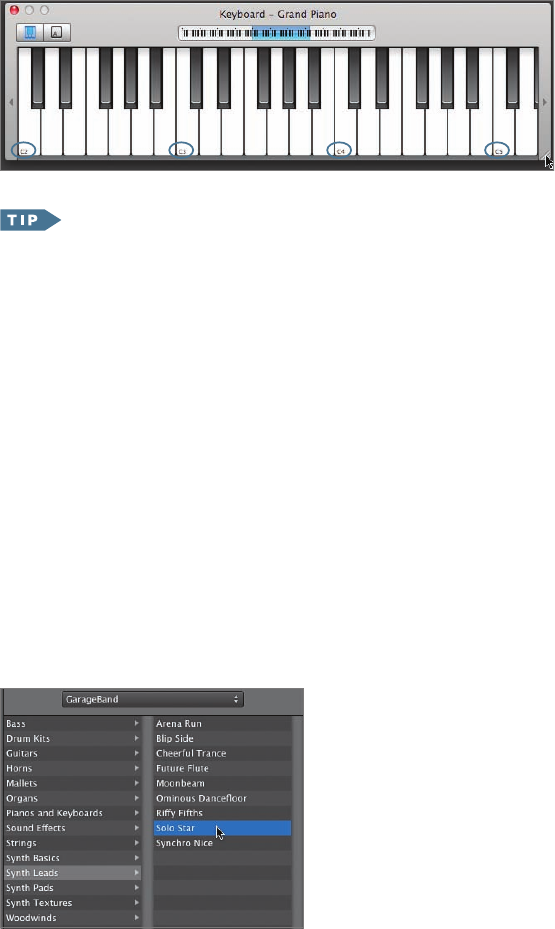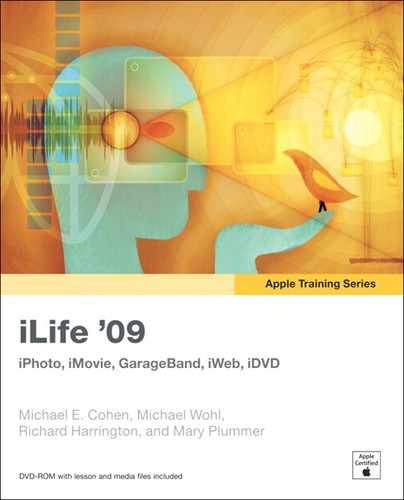Playing the Onscreen Music Keyboard 371
NOTE
Apple Loops are prerecorded music files that are designed to
repeat (loop) over and over as a seamless pattern. Loops are commonly
used for drumbeats, rhythm parts, and other repeating musical sections
within a song. GarageBand includes over 1,000 pre-recorded Apple Loops
that are available in the Loop Browser (Cmd-L).
4 Play the project to hear the default arrangement.
Sounds good, has a fun electronic feel, and would likely turn heads (in a
good way) if it plays in a crowded restaurant. However, it would be even
better if you recorded an additional part to add your own distinctive
sound to the music.
Recording a New Software Instrument Part
Now that your project is set up, it’s time to start recording an additional part.
In this exercise, you’ll record a synth part to complete the ringtone song. Don’t
worry if you aren’t a musician; you’ll still be able to play along and record.
There are three ways to play a Software Instrument in GarageBand.
Connect a MIDI or USB MIDI keyboard to the computer and play the
keys on the musical keyboard. (You can find instructions for connecting
a keyboard in Lesson 11.)
Use Musical Typing to turn your computer’s keyboard into a musical
instrument. (You can try this method in Lesson 12.)
Use the onscreen music keyboard in GarageBand to click the keyboard
keys with your mouse.
Playing the Onscreen Music Keyboard
One option for playing music with GarageBand is the onscreen music keyboard.
You can use the keyboard to both play and record Software Instruments. First,
let’s create a new Software Instrument track that you’ll use to record your part.
1 Choose Track > New Track, then select Software Instrument from the New
Track dialog. Click Create.

372 Creating an iPhone Ringtone
A new Grand Piano track appears below the other tracks in the Timeline.
Grand Piano is the default Software Instrument; however, you can change
it at any time to a different Software Instrument.
2 To show the onscreen music keyboard, choose Window > Keyboard.
The onscreen music keyboard appears, ready to play the selected Grand
Piano track.
NOTE
The onscreen music keyboard works only for Software
Instrument tracks.
3 Drag the lower-right corner of the keyboard down and to the right to
resize it for larger keys that are easier to click.

Playing the Onscreen Music Keyboard 373
The onscreen music keyboard is touch sensitive. Click the top of
the keys near the top of the keyboard to play with a lighter velocity and
get a quieter sound. Click the bottom of the keys near the bottom of the
keyboard to play with a harder velocity and get a louder sound. You can
always change the velocity of Software Instrument notes in the editor after
they’ve been recorded.
4 Play the onscreen keyboard by clicking the notes on the keyboard.
Although you can play music this way, it’s not the easiest way to create
complex music arrangements. However, it will work perfectly for this ring-
tone composition.
Let’s change the track instrument to a synth sound that works better for
this project.
5 On the Track Info pane, choose Synth Leads as the instrument category
(left column) and Solo Star as the instrument.
6 Click a few notes to hear the Solo Star instrument in action.

374 Creating an iPhone Ringtone
The part you’ll play will be incredibly simple. Because the project is in the
key of C, you’ll simply click the C key (marked C2—usually the first key
on a standard keyboard, including the onscreen music keyboard) and drag
the pointer toward the right until you reach the C3 key an octave higher.
Then you’ll do it again starting with the C3 key and dragging toward the
right to C4.
Your goal is to play and hold C2 for the third and fourth measures, and
then drag to C3 during the fifth measure. Hold the C3 note through the
sixth measure. Click C3 again and hold through the seventh and eighth
measures, and then drag to C4 during the ninth measure. Hold the C4
note until the tenth measure.
7 Practice clicking C2 and dragging across the white keys to C3. Then do it
again from C3 to C4. Try again while the song is playing. Choose Control >
Metronome, or press Command-U to turn off the metronome during
your recording.
Don’t worry if you miss a key along the way, or overshoot the last note
and backtrack. Whatever you do will sound fine in this composition.
When you’re ready, go ahead and try recording.
8 Press C to turn off the cycle region for this recording. Press Return to
move the playhead to the beginning of the project.
9 Press R to start recording, and play your part. When you’re finished, press
the spacebar to stop recording.
..................Content has been hidden....................
You can't read the all page of ebook, please click here login for view all page.
